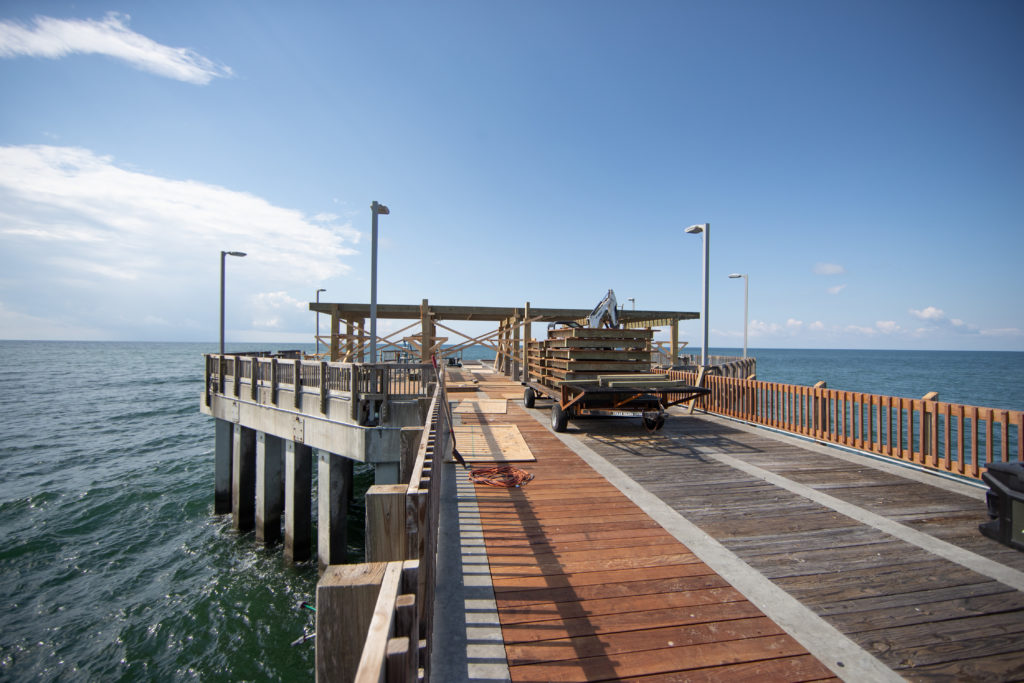By David Rainer.
Lamar Pendergrass believes in the old saying that good things come to those who wait.
The timing of the renovations to Gulf State Park Pier is not what was planned, but Pendergrass assures everyone it will be worth the wait.
“This is going to be what sets the example for any pier that is built on the Gulf of Mexico,” said Pendergrass, Alabama State Parks South Region Operations Supervisor. “If people want to see something that is state-of-the-art and done the right way, this is where they need to be.”
The $2.4 million renovation of one of the premier piers on the Gulf of Mexico is expected to be completed in July after all the decking and handrails have been replaced as the major part of the renovations.
“The problems with the wood we’ve had in the past are rot and deterioration, the effects of weather and the elements over time,” Pendergrass said.
The treated pine timber on top of the pier decking is showing severe wear and tear with splintering and erosion to the point of being unsafe.
“It’s not just the top; it’s the understructure,” Pendergrass said. “The understructure is pine also, and it’s rotten too. We have nothing to screw the deck boards into. Even with 3-inch screws, the joists are too deteriorated to get the board secured. There’s nothing left to hold the board down.
“For practicality and safety issues, we couldn’t delay this process any longer.”
Instead of composite material, a sustainably sourced Brazilian hardwood called ipe (pronounced eepay) was chosen for the decking and top boards on the handrails.
“Ipe is very, very dense and very hard,” Pendergrass said. “It has to be predrilled to secure to the joists. You can’t just drive a screw into it.”
Pendergrass said screws that have been inserted into the ipe are difficult to remove.
“I tried to back out a screw that was in a piece of demo wood, and the head of the screw just popped off,” he said.
Pendergrass said ipe has a projected lifespan of 30 years compared to 10 years for the treated pine that is being replaced.
“Ipe doesn’t flake or become brittle and splinter up on you like the pine will,” he said. “It’s much harder to cut into, which should alleviate some of the incidents where people like to cut their names into the handrail or cut bait on the handrails. That means less wear and tear and less time our staff will have to use to change out boards and rails.”
Instead of the top boards on the handrails lying flat, the boards are tilted to prevent anglers and visitors from leaving material on top of the handrails, and Pendergrass hopes it will discourage birds like gulls and pelicans from using the handrails as perches.
“With the flat boards, we were constantly having to clean them and wash them down,” Pendergrass said. “This will make it a lot easier for us to maintain.”
Renovations include entirely new lighting at the pier. The current pier lighting, also turtle friendly, includes 35-watt low-pressure sodium and 18-watt high-pressure sodium lights, which are obsolete.
The light poles that currently extend about 18 feet above the decking will be replaced with poles that are about 10 feet tall. The new lights will be LED lights that are turtle-friendly and have six-inch shields to block portions of the light beam.
“We’re also going to install a dimmer, so that during turtle season we’ll be able to dim the lights even more,” Pendergrass said. “We’ll still have enough light for people who fish, but it will be turtle-friendly. The new lighting will not only be on the pier but in the parking lot also.”
Pendergrass knows that some dedicated pier anglers were not too happy when the scheduled work on the pier was delayed from last winter to this summer. He said it couldn’t be avoided.
“In a perfect world, we would have started this work in January,” he said. “That is what we had intended to do. Then we were contacted by NOAA (National Oceanographic and Atmospheric Administration) that they were going to require a biological opinion on this pier to assess impact on endangered species.”
READ MORE at outdooralabama.com

